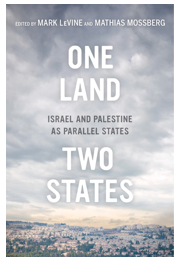PEACE PROPOSAL-As the latest truce between Israel and Hamas hopefully takes root in Gaza, the world is confronted with a humanitarian disaster of monumental proportions. There are nearly 2,000 people dead and 10,000 injured, over 10,000 homes destroyed, over $5 billion in damage to buildings and infrastructure, and half a million people -- almost a third of the population of Gaza -- are displaced.
A long-term solution for Israel and Palestine must be achieved lest there be another bloody war in a couple years. Our proposition? Do away with borders between the two communities.
"We propose Israel and Palestine share the land -- all of it -- as two overlapping, or 'parallel,' states."
An emphasis on territorial borders lends itself to fighting between nation states. Thus, for the last half decade, a group of Israeli, Palestinian and international scholars have developed a solution based on a new notion of sovereignty that -- instead of tied to land -- is tied to citizens. We propose Israel and Palestine share the land -- all of it -- as two overlapping, or "parallel," states. In this scenario, citizenship would follow the citizen wherever she may live within the region of Israel/Palestine.
We call it a "parallel states" scenario because it envisions two states existing in parallel, with overlapping sovereignty across the entirety of historic Palestine, from the Mediterranean to the Jordan River.
The two states would retain their separate identities, national symbols and political structures. But they would be distinguished by their lack of internal borders, allowing free movement and access to land, resources and economic opportunity for the citizens of both states.
A joint defense policy, economic policy and legislative policy would replace existing divisions and ensure the fundamental interests of both states. Here are further specifics of the framework.
"This would eliminate numerous sticking points in the failed Israeli-Palestinian peace processes, including Jerusalem and the Jewish settlements."
Deciding who should belong to which state would -- like the rest of a parallel states structure -- have to be negotiated between the two parties. The division could be based on nationality, individual choice or some other mutually-agreed-upon mechanism. The option of dual nationality must also be taken into account and would most likely play a substantial role -- not least regarding Palestinians who are currently Israeli citizens.
This scenario would eliminate numerous sticking points in the failed Israeli-Palestinian peace processes -- including the issue of sharing or dividing the city of Jerusalem and the issue of Jewish settlements in Palestinian areas. It would allow both peoples' "right of return" to their historic homeland without upsetting the demographic balance within each state. It could keep Israel demographically Jewish and Palestine demographically Palestinian.
The parallel states solution builds on the fact that sovereign space has been ceded to actors other than the nation-state as such: international institutions, transnational companies, major cities and organizations and even private citizens.
Parallel states is reminiscent of the European Union's architecture, wherein the member states have voluntarily ceded layers of sovereignty to a common supranational level of government, while retaining other layers on an exclusively national level. It also serves as a model for other zones of inter-communal territorial conflict, such as many of the former Soviet republics -- particularly Ukraine, Azerbaijan, Armenia and Georgia -- as well as Western Sahara, Cyprus, Kashmir and even Tibet.
We have received positive feedback on this proposal from many sectors of Israeli and Palestinian society, including people close to and even representing the settler movement and Hamas. We see no reason why a strong majority of Israeli and Palestinian societies would not support such a scenario.
"This framework could keep Israel demographically Jewish and Palestine demographically Palestinian."
The people who might be expected to be least sympathetic to a parallel states scenario are precisely those who most benefit from the status quo. But even here, leaders like Prime Minister Netanyahu and Prime Minister Abbas will be forced increasingly to think out of the box as the political, human and strategic costs of the latest war become more evident.
 In the view of the contributors to this project, parallel states is today the only remaining two-state solution available to Israelis and Palestinians. Unlike the failed Oslo accords or a one-state solution, this paradigm can accommodate the complex realities on the ground.
In the view of the contributors to this project, parallel states is today the only remaining two-state solution available to Israelis and Palestinians. Unlike the failed Oslo accords or a one-state solution, this paradigm can accommodate the complex realities on the ground.
Parallel states is no panacea. But in the Holy Land today, 19th-century nation-state borders serve little purpose other than to encourage both sides to fight time and again.
Further details of the parallel states framework are laid out in our new book, One Land, Two States: Israel and Palestine as Parallel States.
(Mathias Mossberg is a former Swedish Ambassador and Mark Leving is an author and professor at UC Irvine. This perspective was posted earlier at HuffingtonPost.com)
-cw
CityWatch
Vol 12 Issue 64
Pub: Aug 8, 2014




